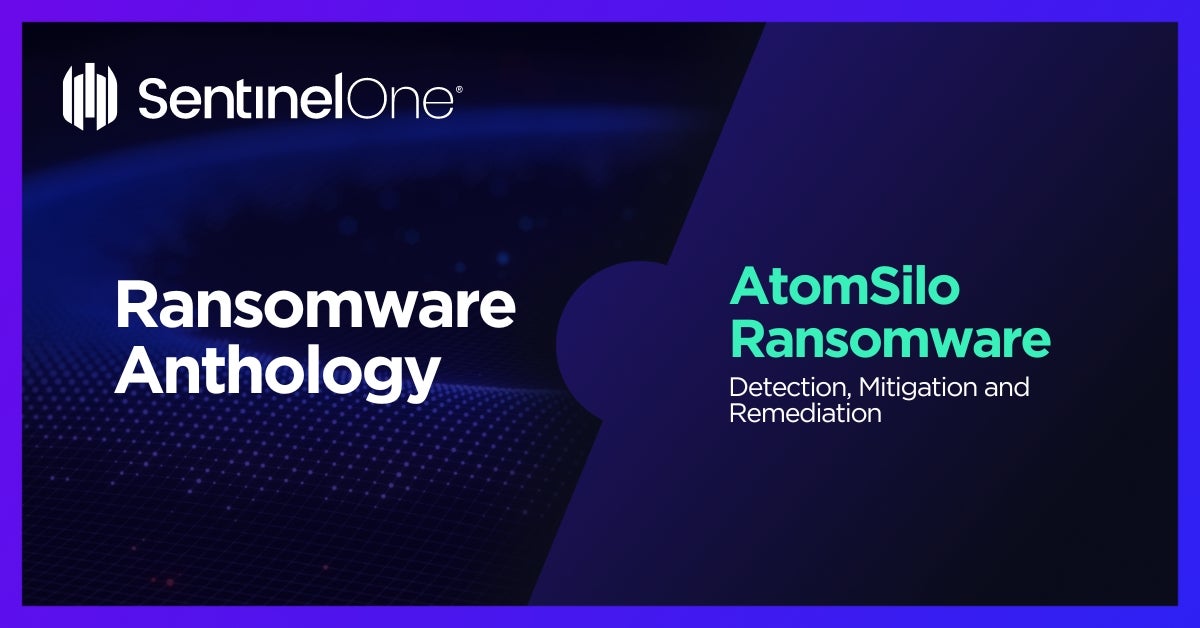AtomSilo Ransomware: In-Depth Analysis, Detection, Mitigation, and Removal
Summary of AtomSilo Ransomware
AtomSilo emerged in September 2021. AtomSilo targets corporate networks and engages in multi- extortion – demanding payment for decryption tools, as well as for the non-release of stolen data. Operators behind AtomSilo gained early traction via their highlighted use of a flaw (CVE-2021-26084) in Confluence software, a popular enterprise collaboration platform.

What Does AtomSilo Ransomware Target?
AtomSilo ransomware typically targets high-value industries such as healthcare, finance, legal, manufacturing, retail, and government. It has also been known to target small to medium-sized businesses. AtomSilo claims to avoid targeting of medical, critical infrastructure, education, or NGO-related entities.
How Does AtomSilo Ransomware Spread?
AtomSilo is delivered via Cobalt Strike or similar framework. AtomSilo has also been observed exploiting known vulnerabilities, for example CVE-2021-26084 – a remote code execution vulnerability in Atlassian Confluence Server
AtomSilo Ransomware Technical Details
AtomSilo was first observed in September of 2021. The ransomware is operated as a RaaS leaving much of the delivery and management to their affiliates. In addition to the reported use of CVE-2021-26804, the ransomware payloads have been observed as malicious attachments in spearphish emails. AtomSilo, as a tenant, claims to avoid the targeting of hospitals, critical infrastructure, oil and gas entities, educational facilities, and nonprofits. The group maintains a TOR-based blog on which they list non-compliant victims and leak their data accordingly. Victims are instructed to contact the attacker (via email or TOR-based payment site) for steps on how to proceed with paying for the decrypter. The price of decryption, in all samples analyzed to date, is $1,000,000 USD. However, if the victim is able to pay within 48 hours, that can be reduced by 50%.
Once AtomSilo is executed, it quickly encrypts files, appending the .ATOMSILO extension. The ransomware payload also deletes itself after execution. AtomSilo is similar to LockBit and its offshoots in that it utilizes a ‘partial’ encryption model which allows for rapid impairing of hosts. It is a full-featured ransomware variety containing a number of anti-analysis and anti-debugging tricks, as well as attempting to stop or terminate processes and services which may interfere with the encryption process.
How to Detect AtomSilo Ransomware
- The SentinelOne Singularity XDR Platform can identify and stop any malicious activities and items related to AtomSilo.
In case you do not have SentinelOne deployed, detecting this ransomware requires a combination of technical and operational measures, which are designed to identify and flag suspicious activity on the network. This allows the organization to take appropriate action, and to prevent or mitigate the impact of the ransomware attack.
- Use antimalware software, or other security tools, which are capable of detecting and blocking known ransomware variants. These tools may use signatures, heuristics, or machine learning algorithms, to identify and block suspicious files or activities.
- Monitor network traffic, and look for indicators of compromise, such as unusual network traffic patterns, or communication with known command-and-control servers.
- Conduct regular security audits and assessments, to identify vulnerabilities in the network and the system, and to ensure that all security controls are in place and functioning properly.
- Educate and train employees on cybersecurity best practices, including how to identify and report suspicious emails, or other threats.
- Implement a robust backup and recovery plan, to ensure that the organization has a copy of its data, and can restore it in case of an attack.
How to Mitigate AtomSilo Ransomware
- The SentinelOne Singularity XDR Platform detects and prevents malicious behaviors and artifacts associated with AtomSilo.
- Public Decryption Tool(s)
If you do not have SentinelOne deployed, there are several steps that organizations can take to mitigate the risk of AtomSilo ransomware attacks.
Educate Employees
Employees should be educated on the risks of ransomware, and on how to identify and avoid phishing emails, malicious attachments, and other threats. They should be encouraged to report suspicious emails or attachments, and to avoid opening them, or clicking on links or buttons in them.
Implement Strong Passwords
Organizations should implement strong, unique passwords for all user accounts, and should regularly update and rotate these passwords. Passwords should be at least 8 characters long, and should include a combination of uppercase and lowercase letters, numbers, and special characters.
Enable Multi-factor Authentication
Organizations should enable multi-factor authentication (MFA) for all user accounts, to provide an additional layer of security. This can be done through the use of mobile apps, such as Google Authenticator or Microsoft Authenticator, or through the use of physical tokens or smart cards.
Update and Patch Systems
Organizations should regularly update and patch their systems, to fix any known vulnerabilities, and to prevent attackers from exploiting them. This includes updating the operating system, applications, and firmware on all devices, as well as disabling any unnecessary or unused services or protocols.
Implement Backup and Disaster Recovery
Organizations should implement regular backup and disaster recovery (BDR) processes, to ensure that they can recover from ransomware attacks, or other disasters. This includes creating regular backups of all data and systems, and storing these backups in a secure, offsite location.
The backups should be tested regularly, to ensure that they are working, and that they can be restored quickly and easily.